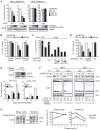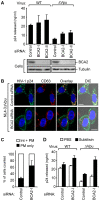BCA2/Rabring7 promotes tetherin-dependent HIV-1 restriction
- PMID: 20019814
- PMCID: PMC2788703
- DOI: 10.1371/journal.ppat.1000700
BCA2/Rabring7 promotes tetherin-dependent HIV-1 restriction
Abstract
Host cell factors can either positively or negatively regulate the assembly and egress of HIV-1 particles from infected cells. Recent reports have identified a previously uncharacterized transmembrane protein, tetherin/CD317/BST-2, as a crucial host restriction factor that acts during a late budding step in HIV-1 replication by inhibiting viral particle release. Although tetherin has been shown to promote the retention of nascent viral particles on the host cell surface, the precise molecular mechanisms that occur during and after these tethering events remain largely unknown. We here report that a RING-type E3 ubiquitin ligase, BCA2 (Breast cancer-associated gene 2; also called Rabring7, ZNF364 or RNF115), is a novel tetherin-interacting host protein that facilitates the restriction of HIV-1 particle production in tetherin-positive cells. The expression of human BCA2 in "tetherin-positive" HeLa, but not in "tetherin-negative" HOS cells, resulted in a strong restriction of HIV-1 particle production. Upon the expression of tetherin in HOS cells, BCA2 was capable of inhibiting viral particle production as in HeLa cells. The targeted depletion of endogenous BCA2 by RNA interference (RNAi) in HeLa cells reduced the intracellular accumulation of viral particles, which were nevertheless retained on the plasma membrane. BCA2 was also found to facilitate the internalization of HIV-1 virions into CD63(+) intracellular vesicles leading to their lysosomal degradation. These results indicate that BCA2 accelerates the internalization and degradation of viral particles following their tethering to the cell surface and is a co-factor or enhancer for the tetherin-dependent restriction of HIV-1 release from infected cells.
Conflict of interest statement
The authors have declared that no competing interests exist.
Figures





References
-
- Goff SP. Host factors exploited by retroviruses. Nat Rev Microbiol. 2007;5:253–263. - PubMed
-
- Freed EO. HIV-1 and the host cell: an intimate association. Trends Microbiol. 2004;12:170–177. - PubMed
-
- Malim MH, Emerman M. HIV-1 accessory proteins–ensuring viral survival in a hostile environment. Cell Host Microbe. 2008;3:388–398. - PubMed
Publication types
MeSH terms
Substances
Grants and funding
LinkOut - more resources
Full Text Sources
Molecular Biology Databases
Miscellaneous

